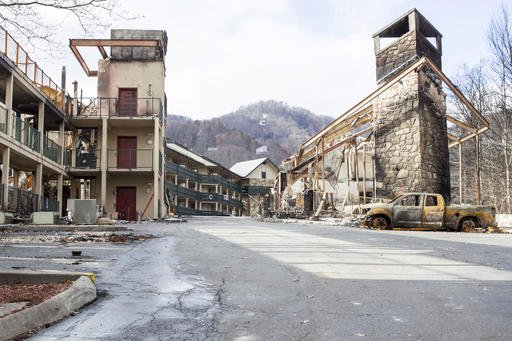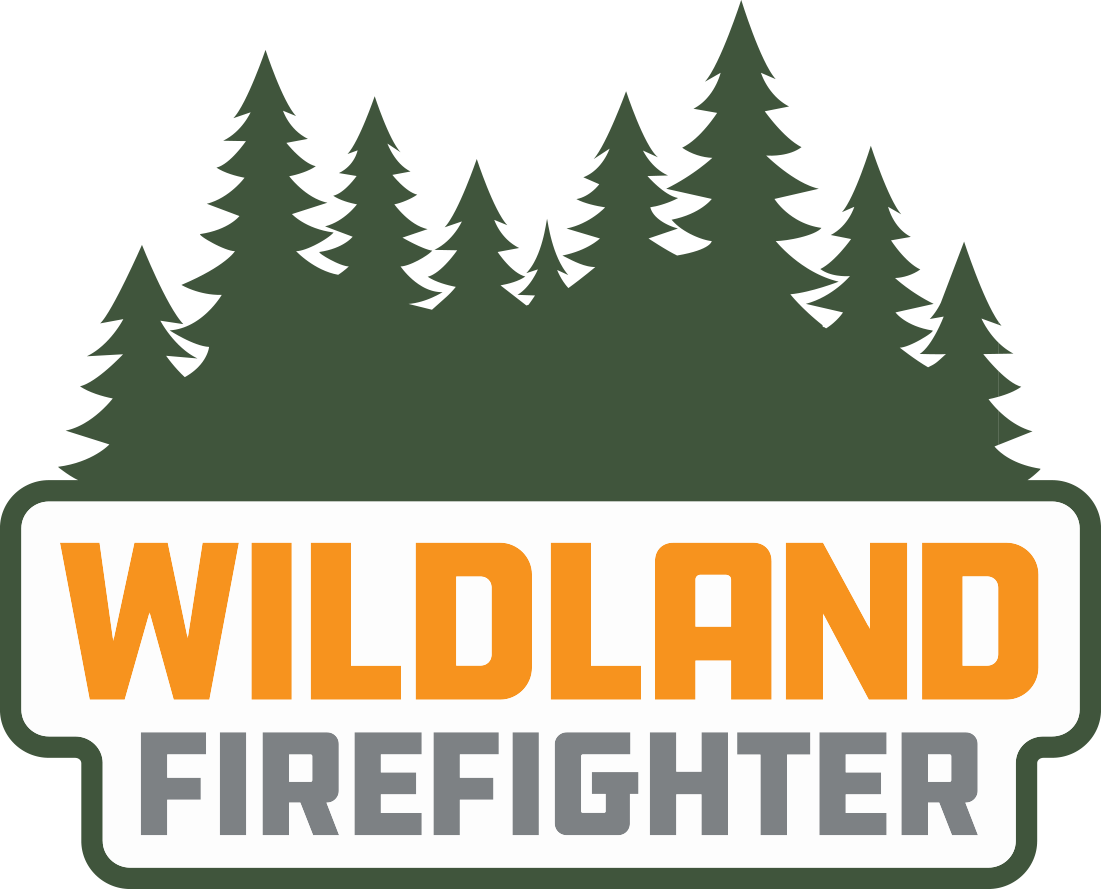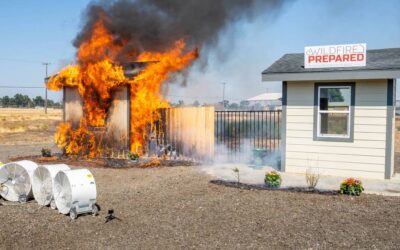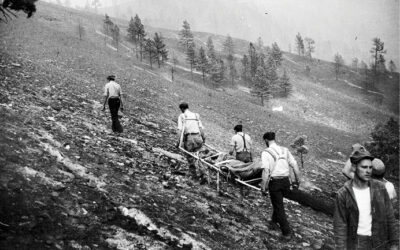County commissioners doubt new codes could have lessened wildfire damage

Fire damage to the Laurel Point Resort in Gatlinburg, Tenn., is seen on Friday, Dec. 9, 2016. Gatlinburg reopened to the public for the first time since fatal wildfires spread to the city on Nov. 28. (AP Photo/Erik Schelzig)
JIM GAINES, Knoxville News-Sentinel
Several Sevier County commissioners said last week they doubted any construction standards would have mitigated loss from a fire as big and fast-moving as the one that devastated Gatlinburg, killing 14 people and damaging or destroying more than 2,400 structures.
But research says the choice of materials, distance from trees, and accessibility to firefighters can greatly increase survival of people and buildings. Most of those are not mandated in Sevier County, though some are recommended.
“Something like this, I don’t know what kind of building codes you could have that would have helped,” Commissioner Phil King said.
Commissioners Gary Cole and Michael Maddron echoed the sentiment.
“This is a tragedy of epic proportions,” Cole said. “As far as I’m concerned, this was a once-in-a-lifetime event that I honestly think wouldn’t ever be replicated in my lifetime.”
Even adopting new codes wouldn’t affect the many older cabins, which are grandfathered in under the minimal standards at the time of their construction. The U.S. Forest Service has a Firewise program with steps that cut the risk to structures, but participation is voluntary.
Information on the wildfire risk in Sevier County has been available for a long time. In 2002 the forestry division declared 65 of 155 developments then standing as being at “very high risk” for fire.
The Chimney Tops 2 fire was reported Nov. 23 in a hard-to-reach area. Four days later it grew rapidly, sweeping out of the Great Smoky Mountains National Park into Gatlinburg and unincorporated Sevier County, lapping at the edge of Pigeon Forge before rain and hundreds of firefighters stopped its progress. More than 14,000 people were evacuated, 14 died, and hundreds lost their homes, vacation properties or belongings.
Two teenagers have been arrested and charged with aggravated arson in connection with the fire, which covered more than 17,000 acres. Authorities have said additional charges could result, and the teens could be moved to Criminal Court if the prosecutor moves to try them as adults.
The risk to houses from forest fires was once considered mostly a “California problem,” Jack Cohen wrote in a 2000 article for the Journal of Forestry. But it grew rapidly nationwide in the 1990s, according to Cohen, a research scientist for the U.S. Forest Service.
The “Wildland-Urban Interface,” or WUI, is where houses meet and mix with wild growth. It’s the “most challenging” area for protecting buildings from wildfire, and where human-started fires are most common, according to a 2005 article in the journal “Ecological Applications.”
“The WUI is where wildland fires destroy the most structures when fuels and weather are conducive to fire and where human-caused fire ignitions are most common,” the six authors wrote. The blend of houses and forest is common on the fringe of metropolitan areas, and the Southern Appalachian region is one of the areas of heaviest concentration.
Sevier County Codes
A new house in Sevier County does not require a state residential building permit, according to the Tennessee Department of Commerce & Insurance.
Sevierville, Pigeon Forge and Gatlinburg have their own code departments, and the state fire marshal’s office may get involved in school, government or commercial construction, but it’s Sevier County officials who oversee housing construction in the unincorporated area, according to Kevin Walters, communications director for the Department of Commerce & Insurance.
Building a house in unincorporated Sevier County requires a “residential zoning compliance permit,” which carries a $100 fee, according to the county website.
“If city sewer is available, a resident would not need any permits,” Eric Ward, spokesman for the Tennessee Department of Environment & Conservation, said via email. “If they need a septic system on site, they would be required to obtain a permit that would meet the state’s groundwater protection regulations. In Sevier County’s case, they issue their own permits.”
The county requires “a set of floor plans, a proof of septic or sewer service; and if you’re not building your primary home, and it’s a second home, we need your contractor’s license and proof of workman’s comp,” said Chris Jenkins, Sevier County building official. There is no regulation on specifically fire-resistant building material, he said.
“We do not have a fire-wise zone regulation as far as separation from foliage,” Jenkins said.
Scope and Standards
Westgate Smoky Mountain Resort & Spa, built in 2000 between Pigeon Forge and Gatlinburg, saw most of its cabins in the wooded hills burn down Nov. 28 while almost all the main buildings – in a cleared and landscaped area next to U.S. 321 – survived.
In total, 652 units and 70 of the 90 buildings at Westgate were destroyed in the wildfire, according to a news release from the company on Friday. Just over 350 units and many of the amenities were unaffected by the blaze, including the resort’s 60,000-square-foot Wild Bear Falls indoor water park, marketplace, fitness center, swimming pool and original check-in building, the release said.
Reconstruction of the damaged units has begun and “the property will be rebuilt to an even better standard than before,” according to David Siegel, president and CEO of Westgate Resorts.
The site swarmed with work crews this week, preparing for its Saturday reopening.
Mark Waltrip, COO for Westgate Resorts, said shortly after the fire that cabins amid the trees bore the brunt of damage, while the larger main buildings on cleared ground suffered little damage. It is the survival of those structures that allowed Westgate to reopen quickly.
Houses in the woods, many of them rental cabins, have always been hard for area firefighters to protect, Pigeon Forge Fire Chief Tony Watson said.
“I’ve lived here all my life, and I think over the years we’ve made some progress,” he said. Some of the older cabins are harder to reach because of narrow roads and steep slopes.
“Those older ones are the ones that give us more of a problem right there,” Watson said.
It’s hard to say exactly how many of those structures there are, according to Justin Jones, whose marketing agency represents the county and manages rentals for more than 50 clients in the area.
His best guess is somewhere between 8,000 and 10,000 in the hills of Sevier County.
“It depends on what you classify as a cabin rental,” Jones said. “Is it a cabin rental that’s rented, or is it a cabin that someone owns and just comes to a couple times a year?”
There’s also a distinction between cabins and chalets.
“A traditional cabin is log inside, log out, or at least wood,” Jones said. Chalets have drywall interiors, making them more like traditional houses, he said.
Many of the houses lost last week were built long before any standards were in place, Cole said.
“The portion of the county that was hard-impacted, as I understand it, is the North Chalet Village area that abuts Gatlinburg; and that was built 30, 40 years ago,” he said.
Sevier County now has zoning regulations, but the resolution only went into effect Sept. 1, 2006.
One of the commissioners who voted to implement zoning is Fred Atchley.
“I don’t feel that government should regulate everyone’s lives, but when it comes to safety of the people, I figure that’s what we were elected to do,” he said.
The 2013 Sevier County Fire
Atchley, who said he has worked as a firefighter all his life – including around Gatlinburg last week – considered the Black Bear Ridge Resort fire in 2013 to be a major blaze.
That fire did more than $12 million in damage, destroying 53 cabins and damaging 20 more at the resort on Lost Branch Road near Pigeon Forge.
It’s “asking for trouble” to build amid thick trees, far from a good water supply; but many cabins like that were built long before any regulation, Atchley said.
The Black Bear fire and other past wildfires that destroyed and damaged mountaintop rental cabins and some private homes were among the reasons Sevier County voted to adopt regulations for development of hillsides and mountaintops.
In 2011, the county set minimum distances between cabins built on hillsides and ridgetops, although that was also about preserving uncluttered views.
Loopholes
The state fire marshal is in charge of enforcing some standards, such as reviewing developers’ plans, Watson said. But even the fire marshal’s rules have had loopholes.
Walters, whose department includes the fire marshal’s office, provided a Jan. 29 memo from state Director of Codes Enforcement Chris Bainbridge that said that two years earlier the fire marshal “discovered that, in some areas of the state, transient rental homes and cabins were classified as one- and two-family dwellings.”
After a fire with multiple deaths in one such building, the fire marshal’s office decided they should be reclassified with hotels, motels and boarding houses for building code purposes.
New rules cover “transient rental homes,” used for up to 30 days, including cabins. Those that are less than four stories, 5,000 square feet and with 12 or fewer occupants can be exempt from sprinklers. Larger ones are classified differently.
The state rules, which will go into effect Feb. 2, say single dwellings, such as rental cabins, can be built under the 2009 International Residential Code if they’re three stories or less, hold 12 or fewer people, and are less than 5,000 square feet, Walters said.
The IRC does include a section on fire-resistant construction, but doesn’t require outside walls rated for fire resistance unless they’re within 5 feet of another building. Roof standards deal with resistance to wind, hail and ice, but have only brief mention of fire-retardant materials. The concern is to resist fire coming from inside the house, not outside. The code includes no mention of distance from exterior trees or brush.
Overnight rental cabins are held to the same standard as motels, but someone who says they’re building a secondary vacation home can avoid that standard, even if they end up renting it out, Watson said.
Cabins well above the individual-rental size already have to be built with sprinklers, which at least help in ordinary fires, he said; but some were built before that requirement – and those were among last week’s losses.
“I looked at several of those large cabins that sleep 80 people that weren’t sprinkled,” Watson said. “When they build them back, there’s no way – unless politics get involved – they can build them back without sprinklers.”
Looking Forward
Sevier County now follows recommendations of the National Fire Prevention Association, Atchley said. The county website lists the 2006 NFPA code as its standard.
“We have voted several times to adopt the NFPA,” Atchley said. That code urges leaving 30 feet between structures, use of fire-resistant materials, and cutting heavy vegetation about 100 feet back from buildings.
County Commissioner Rod Cowan, however, said he hasn’t heard much discussion of building standards since the county set rules in 2011 for building on ridgetops.
“I’m sure there’ll be a lot of stuff talked about later on, once they figure out what all the damage is,” he said.
Commissioners have discussed fire-safety regulations in the past, such as adopting state standards for roads to make them passable for fire trucks, King said.
“And we’ll continue, I’m sure, to look at these things,” he said. “We want people to be able to build, but we want to do it in a manner that’s safe for everybody.”
Maddron said he’s sure a discussion of building standards will come up, but didn’t think they would have mattered in this case. Cole agreed.
Commissioner Mike Chambers said “we go pretty much by state standards,” but doesn’t recall specific past discussions of fire-safety building regulations, and doesn’t expect any in the immediate future.
Watson wants everyone involved to collaborate on setting guidelines for safe growth. That includes developers, renters, planning and code enforcement officials, firefighters and emergency communication workers.
“We have to do responsible development,” he said. “Proper planning helps us mitigate those risks.”
Strain and Safety
In the past few years, “great strides” have been made in fire-resistant construction and fire suppression methods in the country, but those have been offset by an increase in the number and value of buildings, according to the Insurance Information Institute.
Three of the 10 costliest fires of 2015 were wildland-urban interface fires, according to the institute, a nonprofit consumer education group funded by the insurance industry. All three of those fires were on the West Coast.
Close to one out of three houses in the contiguous 48 states is in the wildland-urban interface, multiple researchers say. And they’re spread over a vast territory: the WUI occupies three to five times as much land as urban areas, according to a 2013 study. The U.S. Forest Service is hard-pressed to protect that territory.
“Climate change has led to fire seasons that are now on average 78 days longer than in 1970,” a 2015 Forest Service report said. “The U.S. burns twice as many acres as three decades ago and Forest Service scientists believe the acreage burned may double again by mid-century. Increasing development in fire-prone areas also puts more stress on the Forest Service’s suppression efforts.”
In 1995, the Forest Service spent 16 percent of its federal funding on fire suppression. In 2015 that had climbed to 52 percent.
“By September 2015, the Forest Service had already exceeded the funding set aside for fire suppression and was forced to borrow funds meant for other Forest Service activities,” a USDA news release said.
In fiscal 2016, the Forest Service spent $1.6 billion on fire suppression, requiring extra cash from Congress, according to Mike Illenberg, with the USDA Office of Communications.
In urban fires, usually only one building is damaged or lost; but a fast-moving forest fire can ignite many widely-spread homes in a short time, overwhelming even the best-equipped fire departments, according to researcher Jack Cohen.
“The usual result is that a home either survives or is totally destroyed; only a few structures incur partial damage,” he wrote.
Houses with nonflammable roofs, such as corrugated metal, survive forest fires 70 percent of the time; while houses with wood-shingled or other flammable roofs only survive 19 percent of the time, Cohen found.
The key to preventing wooden walls from catching fire is keeping trees and flammable brush beyond a certain distance, he said. The hot front of a wildfire usually takes only a minute or so to sweep over an area, he found. But if the fire front is kept about 130 feet away from walls, by cutting back trees and brush, it would take at least 10 minutes for the house’s walls to ignite from the heat, according to his research.
Second Thoughts
Atchley said if he were building a house today, he would leave 30 to 40 feet between it and the tree line, put on a metal roof, and have either brick walls or concrete board siding – even if current standards don’t require it.
When he built his current house, he had to settle for what he could afford at the time, Atchley said. But in the wake of the wildfire, he’s looking to upgrade.
“I came home and told my wife, just as soon as I can get this siding off I’m going to replace it with concrete board,” Atchley said.
Atchley is not alone in having second thoughts.
Warren Bielenberg, an GSMNP information officer, said he always wanted a cabin in the woods. But his wife said no.
Now, “it blows me away” to count all the houses built atop heavily wooded ridges, which Bielenberg sees on his 30-odd mile drive to work.
Many cabins like that were lost to the fire, doomed by their isolation, building materials and proximity to the burning forest. That’s what his wife worried about.
Latest Fire Updates
Chimney Tops fire: 17,136 acres, 94 percent contained. Cost: More than $6.5 million
Cobbly Nob fire: 764 acres, 96 percent contained. Cost: $319,154
The death toll remains at 14.
More than 190 people have been treated for fire-related injuries and illnesses.
Two teenage boys, ages 15 and 17, have been arrested on charges of aggravated arson in the Sevier County fires.
Brandon Reese / usa today network – tennessee Fire burns the main entrance of the Westgate Smoky Mountain Resort in Gatlinburg burns on Nov. 29.
Copyright © 2016 LexisNexis, a division of Reed Elsevier Inc. All Rights Reserved.




